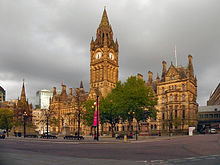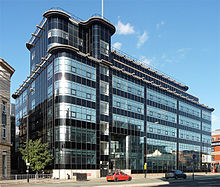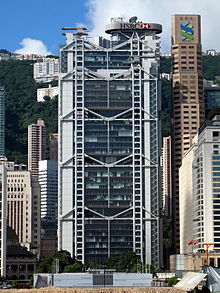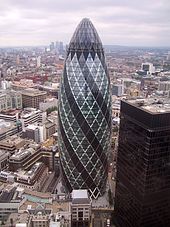
Norman Foster, Baron Foster of Thames Bank
Background to the schools Wikipedia
This selection is made for schools by a children's charity read more. SOS Children is the world's largest charity giving orphaned and abandoned children the chance of family life.
| The Lord Foster of Thames Bank | |
|---|---|
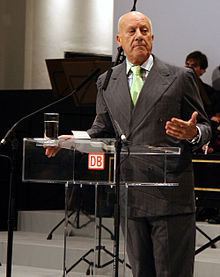 |
|
| Born | 1 June 1935 Stockport, England |
| Nationality | British |
| Awards | Stirling Prize Pritzker Architecture Prize Minerva Medal Prince of Asturias Award AIA Gold Medal |
| Practice | Foster + Partners |
| Buildings |
30 St Mary Axe, London Wembley Stadium |
| Projects | American Air Museum at the Imperial War Museum Duxford |
Norman Robert Foster, Baron Foster of Thames Bank, OM Kt. (born 1 June 1935) is a British architect whose company maintains an international design practice, Foster + Partners.
Foster was raised in Manchester in a working-class family and was intrigued by design and engineering from a young age. His years observing Mancunian architecture subsequently influenced his works, and was inspired to pursue a career in architecture after a treasurer clerk noticed his sketches and interest in Manchester's buildings while he worked at Manchester Town Hall.
Foster gained an internship at a local architect's office before submitting a portfolio and winning a place at the University of Manchester School of Architecture. He subsequently won a scholarship to study at the Yale School of Architecture in the United States of America.
Foster returned to the United Kingdom in 1963 and set up a practice, Team 4 which became Foster + Partners. His breakthrough building was arguably the Willis Building in Ipswich in 1975 and he has since designed landmark structures such as Wembley Stadium and 30 St Mary Axe. He is one of Britain's most prolific architects of his generation. In 1999 he was awarded the Pritzker Architecture Prize, often referred to as the Nobel Prize of architecture. In 2009 Foster was awarded the Prince of Asturias Award in the Arts category. In 1994 he received the AIA Gold Medal.
Biography
Early life in Manchester
Foster was born to Robert Foster and Lilian Smith in 1935 in Reddish, Stockport. Foster has no recollection of Reddish as his parents rented a terraced house, 4 Crescent Grove in Levenshulme, Manchester for fourteen- shillings a week soon after his birth.
Foster's parents were diligent, hard workers - so diligent that Foster, as an only child, felt their heavy workload restricted his relationship with them and he was often looked after by neighbours or other family members. He attended Grammar School in Burnage. He said he always felt 'different' at school and was bullied. He retired into the world of books and was quiet and awkward in his early years making faux pas.
Manchester was 'one of the workshops of the world' during his childhood, and 'the embodiment of a great city'. His father, Robert, worked at Metropolitan Vickers at Trafford Park which fuelled his interest in engineering and design. As a youngster, he was fascinated with engineering and the process of designing which caused him to pursue a career designing buildings. Specific interests included aircraft, a hobby he maintains today; and trains, generated by viewing passing trains on the railway outside his terraced home during his childhood. Foster was not keen on sports, but frequently cycled to the Lake District from Manchester and back the same day.
Foster's father convinced him to take the entrance exam for Manchester Town Hall's trainee scheme which he passed in 1951 and took a job as an office junior in the Treasurer's Department. His parents were pleased, but he was disappointed. Bored with office work, he ventured into the city to observe buildings during his lunch breaks and sketched designs while at his desk. A clerk, Mr Cobb, became aware of Foster's interests. Cobb's son was studying architecture and his interest led to Foster considering a career in architecture. After working in the Manchester City Treasurer's office Foster completed his National Service in 1953 serving in the Royal Air Force, a choice inspired by his passion for aircraft.
Foster returned to Manchester, not wanting to return to the town hall as his parents wished and unsure of which path to follow. With 7 O-levels, he applied for a job at a duplicating office machine company and when asked by the interviewer why he applied, Foster replied: 'mainly because it offered the prospect of a company car, and a £1,000 salary.' Foster was searching for a world away from his working-class roots which led the alienation of his parents.
Education
After failing to gain a job, Foster was led to John Beardstow, a local architect in Manchester. After a successful interview, he gained a job as an assistant to a contract manager at the practice. Foster was unsure how to become an architect, and if it was even possible coming from a working-class background where money for tuition was slim. Nevertheless, he queried colleagues at the architecture practice for advice on how to become an architect. Advised to create a portfolio to hand to an architecture school, he took various drawings, such as perspective and shop drawings from Beardstow's practice as inspiration. Foster intended to submit this portfolio to an architectural school in the hope of gaining, however inadvertently Beardstow was so impressed with the drawings he promoted the young Foster to the drawing department of the practice. However after trying to convince Foster to stay and learn his trade as an architect at Beardstow's, Foster declined and wanted to pursue a place at an architecture school.
After he was discharged, in 1956 Foster won a place at the University of Manchester School of Architecture and City Planning. Foster failed to get a grant to help fund his studies, and being from a working-class background money was at a minimum. He took up a number of part-time jobs to fund his studies in Architecture. His jobs in his teenage years included being an ice-cream salesman, night-club bouncer and working night shifts at the local bakery to make crumpets. He combined these with self-tuition via visits to the local library in Levenshulme. Foster took a keen interest in the works of Frank Lloyd Wright, Ludwig Mies van der Rohe, Le Corbusier and Oscar Niemeyer and graduated from Manchester in 1961.
Foster won the Henry Fellowship to the Yale School of Architecture, where he met future business partner Richard Rogers and earned his Master's degree. Vincent Scully encouraged Foster and Rogers to travel in America for a year. After returning to the UK in 1963 he set up an architectural practice as Team 4 with Rogers and the sisters Georgie and Wendy Cheesman. Georgie (later Wolton) was the only one of the team that had passed her RIBA exams allowing them to set up in practice on their own. Team 4 quickly earned a reputation for high-tech industrial design.
Foster and Partners
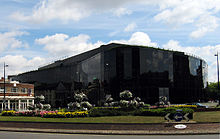
After Team 4 went their separate ways, Foster and Wendy Cheesman founded Foster Associates, which later became Foster and Partners in 1967. A long period of collaboration with American architect Richard Buckminster Fuller began in 1968 and continued until Fuller's death in 1983. They collaborated on several projects that became catalysts in the development of an environmentally sensitive approach to design – including the Samuel Beckett Theatre project.
Originally they concentrated on industrial buildings. The turning point was the 1969 administrative and leisure centre for Fred. Olsen Lines in London Docklands, where workers and managers are not separated any more. Foster and Partners' breakthrough building in the UK was the Willis Faber & Dumas headquarters in Ipswich, of 1974. The client was a family run insurance company which wanted to restore a sense of community to the workplace. Foster created open-plan office floors long before open-plan became the norm. In a town not over-endowed with public facilities, the roof gardens, 25 metre swimming pool and gymnasium enhanced the quality of life for the company's 1200 employees. The building has a full-height glass facade moulded to the medieval street plan and contributes drama, subtly shifting from opaque, reflective black to a glowing backlit transparency as the sun sets. The design was inspired by the Daily Express Building in Manchester a work Foster admired in his youth. The building is now Grade II* listed.
Foster gained a reputation for designing office buildings. In the 1980s he designed the HSBC Main Building in Hong Kong for HSBC. The building is marked by its high level of light transparency, as all 3500 workers have a view to Victoria Peak or Hong Kong bay and the Chinese mainland. Foster said that if the firm had not won the contract it would probably have been bankrupted. Foster believes that attracting young talent is essential, and is proud that the average age of people working for Foster and Partners is 32, just like it was in 1967.
Present day
Foster was assigned the brief for a development on the site of the Baltic Exchange in the 1990s. The Exchange was damaged beyond repair by a bomb left by the IRA. Foster + Partners submitted a plan for a 385 metre tall skyscraper, the London Millennium Tower, but its height was seen as excessive for London's skyline. The proposal was scrapped and instead Foster proposed 30 St Mary Axe, "the gherkin" due to its design which alluded to its shape. Foster worked with engineers to integrate complex computer systems with the most basic physical laws, such as convection. Green, sustainable energy ideas include the complex facade which lets in air for passive cooling and vents it as it warms and rises.
Foster's earlier designs reflected a sophisticated, machine-influenced high-tech vision. His style has evolved into a more sharp-edged modernity. In 2004, Foster designed the tallest bridge in the world, the Millau Viaduct in southern France, with the Millau Mayor Jacques Godfrain stating; "The architect, Norman Foster, gave us a model of art."
In January 2007, The Sunday Times reported that Foster had called in Catalyst, a corporate finance house, to find buyers for Foster + Partners. Foster does not intend to retire, but sell his 80–90% holding in the company valued at £300M to £500M.
In 2007, he worked with Philippe Starck and Sir Richard Branson of the Virgin Group for the Virgin Galactic plans.
Foster currently sits on the Board of Trustees at architectural charity Article 25 who design, construct and manage innovative, safe, sustainable buildings in some of the most inhospitable and unstable regions of the world. He has also been on the Board of Trustees of The Architecture Foundation.
Recognition
In 1986, he was awarded an honorary degree (Doctor of Science) from the University of Bath.
Foster was knighted in 1990 and appointed to the Order of Merit in 1997. In 1999, he was created a life peer, as Baron Foster of Thames Bank, of Reddish in the County of Greater Manchester. As a resident of Switzerland, in 2010 he stepped down from his seat in the House of Lords in order to maintain his non-domiciled status, and so be able to avoid paying UK residents' taxes on income earned abroad. Foster was criticised by some in the architecture world for not advocating the importance of high standards of architecture and planning whilst a member of the House of Lords. Foster last spoke in the Lords in 2003 before his resignation in 2010.
He is the second British architect to win the Stirling Prize twice: the first time for the American Air Museum at the Imperial War Museum Duxford in 1998, and the second for 30 St Mary Axe in 2004. In consideration of his whole portfolio, Foster was awarded the Pritzker Architecture Prize in 1999. He is a Fellow of the Chartered Society of Designers and winner of the Minerva Medal, its highest award. Foster is a Senior Fellow of the Design Futures Council.
Foster received the The Lynn S. Beedle Lifetime Achievement Award from the Council on Tall Buildings and Urban Habitat in 2007 to honour his contributions to the advancement of tall buildings.
He was awarded the Aga Khan Award for Architecture, for the University of Technology Petronas in Malaysia, and in 2008 he was granted an honorary degree from the Dundee School of Architecture at the University of Dundee. In 2009 he received the Prince of Asturias Award in the category Arts.
Personal life
F A qualified pilot, Foster flies his private jet and helicopter between his home above the London offices of Foster + Partners to his homes in France and Switzerland. In 2007, Foster bought the Château de Vincy in Gilly, Switzerland from the German industrialist Charles Grohe. It became his home from late 2008. He recently bought a 18 million EUR house on Martha's Vineyard.
Selected projects
Foster has established an extremely prolific career in the span of four decades. The following are some of his major constructions:
Completed

- 1969–1971, Fred. Olsen Lines terminal, London Docklands, UK
- 1970–1971, IBM Pilot Head Office, Cosham, Portsmouth, UK
- 1971–1975, Willis Faber and Dumas Headquarters, Ipswich, UK
- 1973-1977, Beanhill Housing Estate, Milton Keynes, UK
- 1974–1978, Sainsbury Centre for Visual Arts at the University of East Anglia, Norwich, UK
- 1983, Renault Distribution Centre, Swindon, UK
- 1979–1986, HSBC Main Building, Hong Kong
- 1981–1991, Terminal building at London Stansted Airport, UK
- 1992, Torre de Collserola, Barcelona, Spain
- 1984–1993, Carré d'Art, Nîmes, France
- 1993, Kings Norton Library, Cranfield University, UK
- 1993, Lycée Albert Camus, Fréjus, France
- 1994, Joslyn Art Museum, Omaha, Nebraska, United States
- 1988–1995, Metro of Bilbao, Spain
- 1995, Faculty of Law, Cambridge
- 1995–1997, The Clyde Auditorium, part of the Scottish Exhibition and Conference Centre in Glasgow, Scotland
- 1996, National Sea Life Centre, Birmingham, UK
- 1991–1997, Commerzbank Tower, Frankfurt, Germany
- 1992–1998, Hong Kong International Airport, Chek Lap Kok, Hong Kong
- 1993–1998, Valencia Congress Centre, Valencia, Spain
- 1999, Redevelopment of the Great Court of the British Museum, London, UK
- 1999, Social Sciences Division, Manor Road Building, University of Oxford, UK
- 1999, Reichstag restoration, Berlin, Germany
- 2000, Greater London Authority Building (London City Hall), London, UK
- 1996–2000, Millennium Bridge, London, UK
- 2000, Centre for Clinical Science Research, Stanford University, Palo Alto, United States
- 2001, Expo MRT Station, Singapore
- 2001, Al Faisaliyah Centre, Riyadh, Saudi Arabia
- 2001, La Poterie metro station, Rennes, France
- 2001, J Sainsbury headquarters, Holborn Circus, London, UK
- 1999–2001, Lionel Robbins Building renovation, British Library of Political and Economic Science, London School of Economics, London, UK
- 2002, 8 Canada Square (HSBC Group Head Office), London, UK
- 1997–2003, Metropolitan Building in Warsaw, Poland
- 2003, Clark Centre, Stanford University, Palo Alto, United States
- 2003, Universiti Teknologi Petronas main campus, Malaysia
- 2003, Capital City Academy, London, UK
- 1997–2004, 30 St Mary Axe, Swiss Re London headquarters, London, UK
- 2004, The Sage Gateshead, Gateshead, UK
- 2004, Moor House, London, UK
- 2004, McLaren Technology Centre, Woking, UK
- 2004, Tanaka Business School, Imperial College London, UK
- 2004, The Millau Viaduct, near Millau, France
- 2005, Supreme Court Building, Singapore
- 2005, Western Årsta Bridge, Stockholm, Sweden
- 2005, 40 luxury apartments, St. Moritz, Switzerland
- 2005, National Police Memorial, The Mall, London, UK
- 2005, The Philological Library at the Free University of Berlin, Germany
- 2005, Deutsche Bank Place, Sydney, Australia (the first Sir Norman Foster building in the Southern Hemisphere)
- 2002–2006, Dresden Hauptbahnhof reconstruction, Dresden, Germany
- 2006, Hearst Tower, New York City, United States
- 2006, Leslie L. Dan Pharmacy Building at the University of Toronto, Toronto, Canada
- 2006, Palace of Peace and Reconciliation, Astana, Kazakhstan
- 2002–2007, Wembley Stadium, London, UK
- 2004–2007, The Willis Building, City of London, UK
- 2005–2007, Thomas Deacon Academy
- 2004–2007, Kogod Courtyard, Centre for American Art and Portraiture at the National Portrait Gallery, Washington, DC
- 2007, International Terminal, Beijing Capital International Airport, Beijing, China
- 2006–2008, Lumiere residences, Regent Place, Sydney, Australia
- 2006–2008, John Spoor Broome Library, California State University Channel Islands, United States.
- 2007–2008, New Elephant House, Copenhagen Zoo, Copenhagen, Denmark
- 2004–2008, Torre Caja Madrid, Madrid, Spain
- 2010, Art of the Americas Wing at the Museum of Fine Arts, Boston, Boston, Massachusetts, United States
Proposed or under construction

- Florence TAV Station, Florence, Italy (2003–2010)
- York University subway station- Toronto, Canada (Opening 2015)
- Palmer Tompkinson Building, Longslade 2012
- South Beach, Singapore, Singapore, 2012
- Centro Cultural, Bogota, Colombia (2013)
- APIIC Tower, Hyderabad, India (2007–2020)
- Black Sea Gardens, Byala, Bulgaria (2008)
- Tower, Cork, Republic of Ireland, (2008–2011)
- Culture and Leisure Centre, Ciudad del Motor de Aragón , Alcañiz, Spain (2007) (competition won)
- Tivoli Hotel, Copenhagen, Denmark (2010) (competition won)
- Museum of Aviation, Getafe, Spain (currently in design phase)
- 200 Greenwich Street, Tower 2 of the planned reconstruction of the World Trade Centre in New York City, United States (under construction)
- Reconstruction of New Holland Island, Saint Petersburg, Russia (ongoing)
- U2 Tower, Dublin, Ireland (2008–2011) (competition won) (construction postponed)
- Spinningfield Square, Manchester, UK (2005–2010)
- 1 Hardman Square, Manchester, UK (2011–2014)
- Dallas Centre for the Performing Arts, Dallas, United States (2009)
- The Bow, Calgary, Canada (2007–2011)
- Jameson House, Vancouver, Canada
- The Troika , Kuala Lumpur, Malaysia (2004–2009)
- Queen's Dock, Scottish Exhibition and Conference Centre, Glasgow, Scotland (2004–2007)
- Supreme Court of the United Kingdom, Middlesex Guildhall, London, United Kingdom (2009)
- Khan Shatyry in Astana, Kazakhstan.
- Masdar City, Abu Dhabi (2007–2023)
- New Yale School of Management campus, New Haven, CT (announced 4 September 2007)
- Crystal Island, Moscow, Russia
- Zagreb Airport, Zagreb, Croatia
- Hermitage Plaza, Paris ( La Défense), France (2010–2014)
- Dubai Towers, Melbourne (TBD)
- Edmond and Lily Safra Centre for Brain Sciences, Hebrew University of Jerusalem, Israel.
- Future Apple Campus in Cupertino, California.
- The City Ground -Nottingham home of nottingham forest stadium upgrade and expansion(2014)
Non-architectural projects
Foster's other design work has included the Nomos desk system for Italian manufacturer Tecno, and the motor yacht Izanami (later Ronin) for Lürssen Yachts.
In October 2010, CNN announced that Foster recreated Buckminster Fuller's Dymaxion car.
